《英语短篇小说选读》讲义(第十四周给学生的)
- 格式:ppt
- 大小:330.00 KB
- 文档页数:31

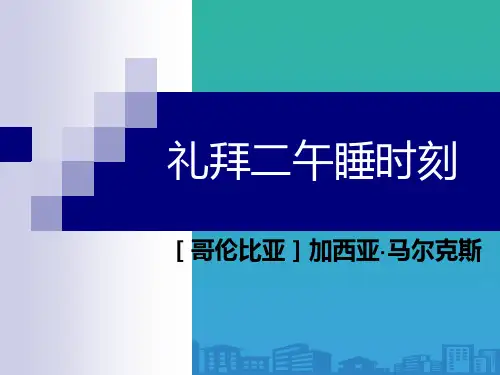
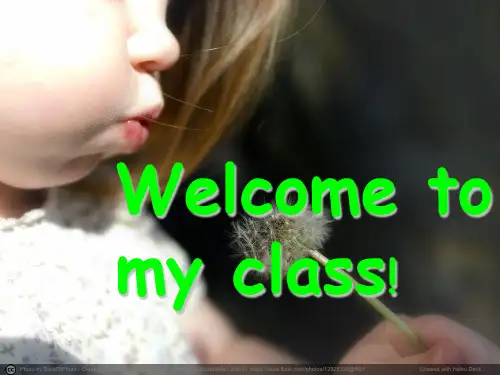
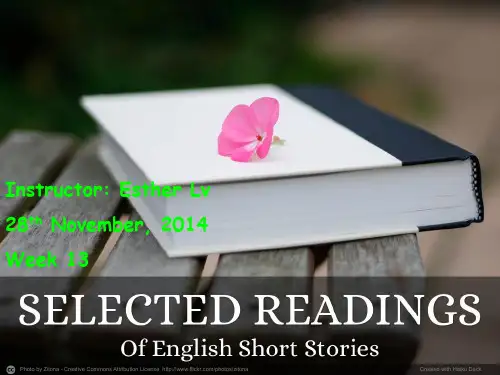
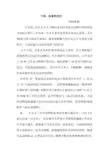
十四、迟来的关注马特•米勒在美国,许多人并不了解日本帝国军队在侵略中国时所犯下的滔天罪行。
在日本,许多人甚至试图否认南京大屠杀。
艾里斯•张写的《南京大屠杀》,就是要提醒人们牢记六十年前犯下的罪行。
下面这篇文章是对这本书的评论。
六十年前,日本帝国军队发动的南京大屠杀,在人类所犯下的集体罪行记录中位置醒目。
在不到两个月的时间里,日军杀害了15-30万手无寸铁的中国公民,强奸折磨了10多万中国妇女。
这是一次野蛮的集体暴行,至今许多日本人不能解释,或根本不承认曾经发生过这样的事情。
在美国,有一系列会议安排在南京大屠杀周年日召开-- 自12月13日起持续近六周的时间-- 试图重新激起对这一恐怖事件长期冷漠了的兴趣。
多数美国人根本不了解发生于1937年12月至1938年1月的大屠杀,也不清楚它与二战之间的关系。
在这次试图重新激起人们关注活动中起中心作用的,是伊瑞斯•张的新作《南京的强奸》。
张,二十九岁,住在加利福尼亚矽谷桑尼威尔市,它位于旧金山以南一百公里。
一位美籍华人作家在美国科技腹地正率先对日军进行谴责,既要求日方承认罪行,担负责任,又要求得到美国大众的认可,这并非偶然。
张和她的著作是美国国内的一场重大运动的标志。
它要求共享历史。
随着少数民族群体逐渐在经济、社会和政治方面树立起了信心,他们努力工作,向前迈进,好让人们听到自己的历史故事。
“这是对全体美国人提出的要求,要他们融合其他民族的历史,壮大自己,”薇拉•施瓦茨说。
她是康涅狄格州韦斯勒因大学的中国历史教授。
这场运动在任何地方都比不上在加利福尼亚的一些富有的亚裔美国人社区更引人注目。
“我去了学校图书馆,发现这方面的资料竟如此之少,非常震惊。
”住在洛杉矶的韩裔美国作家李赫利说。
她那本颇受批评家好评的回忆录《生存之粮》,讲述了她祖母在落入日军魔掌后战胜巨大困难的故事,非常引人入胜。
她说:“作为亚裔美国人,我们应该提供资料,应该说出来。
”南京大屠杀为美籍华人提供了一个令人信服的兴趣点,他们施加压力,使旧金山联合校区把大屠杀写入高中的历史课程。


What is Literature?College of Foreign LanguagesZheng BorenDefinition of Literature⏹For centuries, writers, literary historians, and others have debated bout butfailed to agree on a definition for this term.⏹Some assume that literature is simply anything that is written, therebydeclaring a city telephone book, a cook book, and a road atlas to be literary works along with David Copperfield and the Adventures of Huckleberry Finn.⏹Derived from the Latin littera, meanin g “letter,” the root meaning of literaturerefers primarily to the written word and seems to support this broad definition.However, such a definition eliminates the important oral traditions on which much of western literature based, including Homer’s Ili ad and Odyssey, the English epic Beowulf, and many Native legends.⏹To solve this problem, others choose to define literature as an art, therebyleaving open the question of its being written or oral. This further narrows its meaning, equating literature to works of the imagination or creative writing.⏹Whether one accepts this definition, many argue that a text must have certainpeculiar qualities before it can be dubbed literature. For example, the artist’s creation or secondary world often mirrors the au thor’s primary world, the world in which the creator lives and moves and breathes. Because reality or the primary world is highly structured, so must be the secondary world. To achieve this structure, the artist must create plot, character, tone, symbols, conflict, anda host of other elements or parts of the artistic story, with all of these elementsworking in a dynamic relationship to produce a literary work.⏹Some would argue that it is the creation of these elements—how they are usedand in what context—that determines whether a piece of writing is literature.⏹What literary work may contain is a peculiar aesthetic quality—that is, someelement of beauty—that distinguishes it as literature from other forms of writing.⏹Still other critics add the test-of-time criterion to their essential components ofliterature. if a work withstands the passage of time and is still being read centuries after its creation, it is deemed valuable and worthy to be called literature.Functions of Literature (1)⏹Literature helps us grow, both personally and intellectually;⏹it helps us connect ourselves to the broader cultural, philosophic, and religiousworld of which we are a part;⏹it enables us to recognize human dreams and struggles in different places andtimes that we would never otherwise know;⏹it gives us the knowledge and perception needed to appreciate the beauty oforder and arrangement, just as a well-structured song or a beautifully done painting can;⏹it provides the comparative basis from which we can see worthiness in the aimsof all people, therefore helping us see beauty in the world around us;Functions of Literature (2)⏹it exercises our emotions through interest, concern, tension, excitement, hope,fear, regret, laughter, and sympathy.⏹Through cumulative experience in reading, great literature shapes our goals andvalues by helping us clarify our own identities, both positively, through acceptance of the admirable in human beings, and negatively, through rejection of the sinister. It helps us shape our judgments through the comparison of the good and the bad.⏹Both in our everyday activities and in the decisions we make as individuals andas citizens, it enables us to develop a perspective on the events that occur around us and in the world at large, thereby enabling us to gain understanding and control.Types of Literature: the Genres⏹1) narrative,⏹2) poetry,⏹3) drama,⏹4) nonfiction prose⏹All are art forms, each with its own internal requirements of structure and style. Narrative⏹ A narrative is an account of a series of events, usually fictional, althoughsometimes events in fiction may also be historical.⏹The two kinds of narrative fiction you will read most often are s hort stories andnovels. Myths, parables, romances, and epics are also part of the genre.Short Story⏹ A short story is usually about one or two characters undergoing difficulty orfacing a problem.⏹The relationships among the characters are described briefly, for the shortenedform of the story does not permit leisurely or extensive development of gradual changes in character.Novel⏹the full and sometimes exhaustive development of interactions, for it is adeliberately longer form.⏹Like the short story, the novel usually focuses on a small number of characters. Poetry⏹Poetry is a broad term that includes many subtypes, such as sonnet, lyric,pastoral, ballad, song, ode, drama, epic, and dramatic monologue.⏹Poetry is a compressed, and often deeply emotional, form.⏹It is this compactness of expression, combined with the broadness of application,that makes poetry unique.Drama⏹ A drama or play is designed to be performed on a stage by living actors.⏹Drama presents speech and action which render the interactions that causechange in the characters and resolve the conflicts among the characters.⏹The dramatic types are tragedy, comedy, and farce.⏹Tragedy: human disasters/ elevate human values/ show the most admirablequalities of human beings⏹Comedy: treats people as they are/ laughing at them or sympathizing with them/showing them to be loving and successful.⏹Farce: exaggerates human foolishness/ gets the characters into improbable andlunatic situations, and laughs at everyone in sight.Nonfiction Prose⏹This is a broad term including short forms like essays and articles and alsolonger non-fictional and non-dramatic works.⏹The essay or article is a form for idea, interpretations, and descriptions.⏹The topics are unlimited; they may be on social, political, artistic, scientific, andother subjects.Literary Studies⏹Literary Study is not innocent, but sophisticated. It includes following threeaspects:⏹Study of Literary history⏹Study of Literary works⏹Study of Literary criticismLiterary History⏹It traces the development of literature in a chronological order from a historicalpoint of view.⏹Every individual writer exists in a certain milieu—the political and economiccontext, the social institutions, the emotional and intellectual climate.Literary Works⏹A work of literature is written by an individual, marked by his special personalityand personal past.⏹The literary work represents in a deep way the writer’s attempt to confront andfind meaning in his experience.Literary Criticism⏹“Three R’s”—the writer, the writing, and the reader⏹Relationships: complex rather than simple, dynamic rather than static⏹Assumption 1: there is no such thing as an innocent reading of a text.⏹Whether our responses to a text are emotional and spontaneous or will-reasonedand highly structured, all such interactions are based upon some underlying factors that cause us to respond in a particular fashion. What elicits these responses and how a reader makes sense out of a text is what really matters. And it is the domain of literary theory to question our initial and final responses, our beliefs, our feelings, and our overall interpretation.⏹Assumption 2: Since our responses to a text have theoretical bases, I presumethat all readers have a literary theory.⏹Consciously or unconsciously, we as readers have developed a mind-setconcerning our expectations when reading any text (be it a novel, a short story, a poem, or any other type of literature). Somehow, we make sense out of printedmaterial. The methods we use to frame our personal interpretations of any text involve us in the process of literary criticism and theory, and automatically make us practicing literary critics whether we know it or not.⏹My third assumption rests on the observation that each reader’s literary theoryand accompanying methodology is either conscious or unconscious, complete or incomplete, informed or ill-informed, eclectic or unified.⏹Since an unconscious, incomplete, ill-formed, eclectic literary theory morefrequently than not leads to illogical, unsound, and disorganized interpretations, I believe that a well-defined, logical, and clearly articulated theory will enable readers to develop their own methods of interpretation, permitting them to order, clarify, and justify their personal appraisals of any text in a consistent and rational manner.Can a story have multiple meanings?(can a text have more than one interpretation?)⏹Not all readers interpret texts in the same way. In fact, they voiced theirunderstandings of the story gave fundamentally different interpretations.⏹Our response to any text is largely a conditioned or socially constructed one; thatis, how we arrive at meaning in fiction is in part determined by our past experiences. Consciously or unconsciously, we have developed a mindset or framework concerning our expectations when reading a novel, short story, poem, or any other type of literature. In addition, what we choose to value or uphold as good or bad, moral or immoral, or beautiful or ugly within a given text actually depends on this ever-evolving framework. When we can clearly articulate our mental framework when reading a text and explain how this mindset directly influences our values and aesthetic judgments about the text, we are well on our way to developing a coherent, unified literary theory.⏹The relationship between literary theory and a reader’s per sonal worldview isbest illustrated in the act of reading itself. When reading, we are constantly interacting with the text.⏹According to Rosenblatt’s text The Reader, the Text, the Poem (1978), during theact or event of reading, “A reader brings to the text his or her past experience and present personality. Under the magnetism of the ordered symbols of the text, the reader marshals his or her resources and crystallizes out from the stuff of memory, thought, and feeling a new order, a new experience, which he/she sees as the poem.This becomes part of the ongoing stream of the reader’s life experience, to be reflected on from any angle important to him or her as a human being.”⏹Accordingly, Rosenblatt declares that the relationship between the reader and thetext is not linear, but transactional; that is, it is a process or event that takes place at a particular time and place in which the text and the reader condition each other. The reader and the text transact, creating meaning, for meaning does not ex ist solely within the reader’s mind or within the text, Rosenblatt maintains, but in the transaction between them. To arrive at an interpretation of a text, readers bring their own “temperament and fund of past transactions to the text and live through a process of handling new situations, new attitudes, new personalities,[and] new conflicts in value. They can reject, revise, or assimilate into the resource with which they engage their world.” Through this transactional experience, readers consciously and unconsciously amend their worldview.How to Analyze and Approach an English Poem?⏹I. Suggestions:⏹ 1. Read not only once⏹ 2. look into reference books (dictionary, Bible, etc.)⏹ 3. Read so as to hear the sound yourself⏹ 4. Pay a careful attention to what the poem is saying⏹ 5. Read affectionatelyII. A Number of Questions :⏹ 1. Who is the speaker? What kind of person is he?⏹ 2. To whom is he/she speaking?⏹ 3. What is the occasion?⏹ 4. What is the setting in time?⏹ 5. What is the setting in place?⏹ 6. What is the central purpose of the poem? State a central idea.⏹7. Discuss the theme of the poem.⏹8. How does it achieve?⏹9. a. Outline the poem so as to show the structure of the poem/ b. Summarize theevents of the poem⏹10. Paraphrase the poem⏹11. Discuss the diction of the poem. Point out words that are particularlywell-chosen and explain why.⏹12. Discuss the imagery of the poem. What kind of imagery is used?⏹13. Point out examples of metaphor, simile, personification, and metonymy;explain their appropriateness.⏹14. Point out and explain any symbols. Explain allegory⏹15. Point out and explain examples of paradox, overstatement, understatement& irony. What are their functions?⏹16. Compare the poetic language involved in a poem with the common language.⏹17. What have you learned from the poem in terms of its moral, aesthetic andartistic value?⏹18. Do you like or dislike the poem? Give a brief account for your response.⏹19. Could you liken/ compare this English poem to certain Chinese poetic work?⏹20. Try to translate the English poem into Chinese.How to Read Novels (6 Parts)⏹I. Narrator: Two types1. First person narrator (First Person Point of View)⏹1). First Person as Central Character: David Copperfield⏹2). First Person as Secondary Character: The Great Gatsby2. Third Person⏹1). Omniscient narrator⏹2). Narration limited to the point of view of major characterII. Plot + Structure:⏹Is there a direction? Where is it going? How does it develop? (Four Patterns) III. Character⏹How are characters introduced? (age, name, appearance, morality, etc.)⏹Who is the central character? (protagonist vs. antagonist)⏹What are his or her distinguished characteristics?⏹By what means the author demonstrate?⏹To what extent is the character defines by contrast with minor characters? Orby conflict with his or her environment?⏹Does the novel or story show the growth of change of character?⏹How much of the meaning (theme) depends on the growth of change?IV. Theme/ Purpose⏹Does the novel or story make a general statement about life or experience?V. Techniques:⏹What techniques or devices has the author employed? Any symbols? Anyallusions?⏹ 1. allusion- The Bible, the Greek or Roman Mythology, the Classical works⏹ 2. Stream of consciousness⏹ 3. Rhetoric devices (metaphor, simile)IV. Language + Style⏹What is the style of the novel?⏹What are the characteristics of the language? (simple words?/bigwords?/repetition?/ colloquial or formal?)。
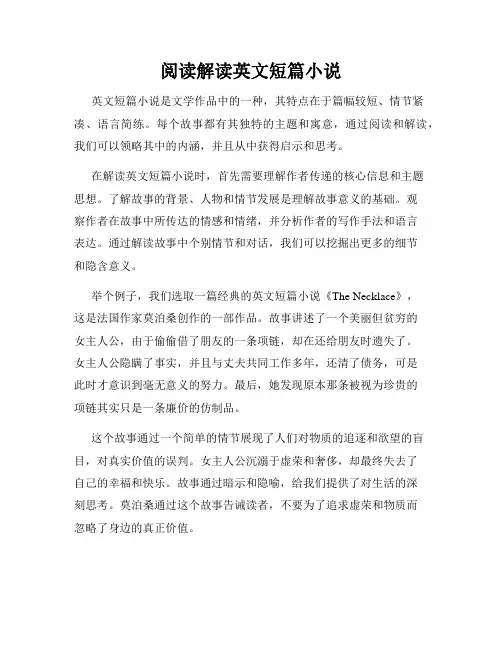
阅读解读英文短篇小说英文短篇小说是文学作品中的一种,其特点在于篇幅较短、情节紧凑、语言简练。
每个故事都有其独特的主题和寓意,通过阅读和解读,我们可以领略其中的内涵,并且从中获得启示和思考。
在解读英文短篇小说时,首先需要理解作者传递的核心信息和主题思想。
了解故事的背景、人物和情节发展是理解故事意义的基础。
观察作者在故事中所传达的情感和情绪,并分析作者的写作手法和语言表达。
通过解读故事中个别情节和对话,我们可以挖掘出更多的细节和隐含意义。
举个例子,我们选取一篇经典的英文短篇小说《The Necklace》,这是法国作家莫泊桑创作的一部作品。
故事讲述了一个美丽但贫穷的女主人公,由于偷偷借了朋友的一条项链,却在还给朋友时遗失了。
女主人公隐瞒了事实,并且与丈夫共同工作多年,还清了债务,可是此时才意识到毫无意义的努力。
最后,她发现原本那条被视为珍贵的项链其实只是一条廉价的仿制品。
这个故事通过一个简单的情节展现了人们对物质的追逐和欲望的盲目,对真实价值的误判。
女主人公沉溺于虚荣和奢侈,却最终失去了自己的幸福和快乐。
故事通过暗示和隐喻,给我们提供了对生活的深刻思考。
莫泊桑通过这个故事告诫读者,不要为了追求虚荣和物质而忽略了身边的真正价值。
解读英文短篇小说并不仅仅是理解故事本身,还需要将故事中展现的主题和情感联系到现实生活中。
我们可以从中获得启示,思考人生,反思自己的行为和价值观。
通过阅读解读英文短篇小说,我们可以扩展自己的词汇量,提升阅读理解能力和英语写作水平。
同时,我们还可以感受到不同文化的魅力和多样性,从而开阔自己的思维。
阅读英文短篇小说也是学习英语的一种有效方式,通过阅读和分析英文原文,我们可以更好地理解和运用英语语言。
总结来说,阅读解读英文短篇小说是提升自己的阅读能力和文学品味的一种方式。
通过理解故事的主题和情感,我们可以丰富自己的思维和认知,同时也可以提升自己的英语水平。
愿每个人在阅读解读英文短篇小说的过程中,都能够获得满满的收获和惊喜。
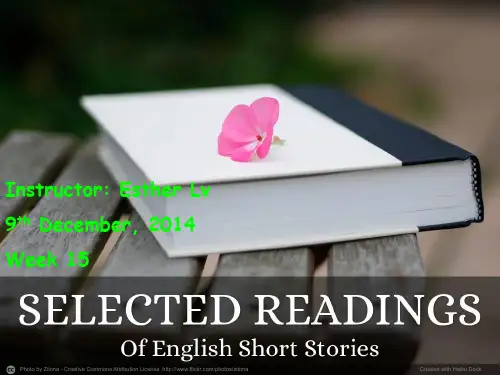
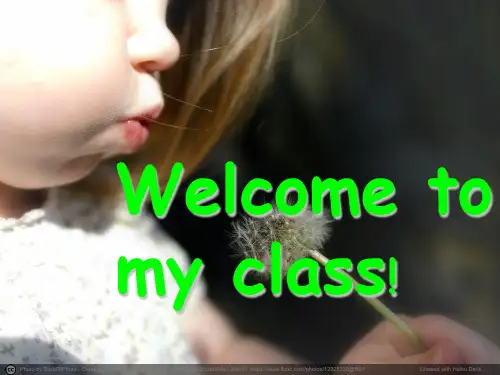
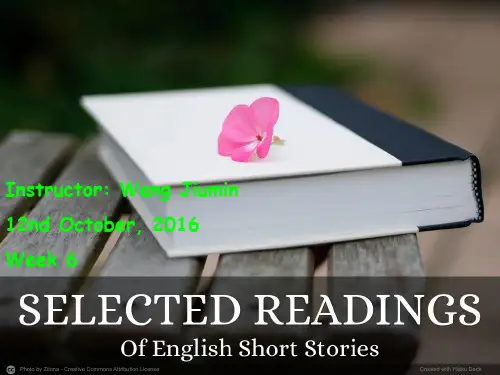
高中英语选修课:英语文学欣赏SisterCarrie学生版讲义资料第一篇:高中英语选修课:英语文学欣赏 Sister Carrie 学生版讲义资料Chapter III WEE QUESTION OF FORTUNE--FOUR-FIFTY A WEEKOnce across the river and into the wholesale district, she glanced about her for some likely door at which to apply.As she contemplated the wide windows and imposing signs, she became conscious of being gazed upon and understood for what she was--a wage-seeker.She had never done this thing before, and lacked courage.To avoid a certain indefinable shame she felt at being caught spying about for a position, she quickened her steps and assumed an air of indifference supposedly common to one upon an errand.In this way she passed many manufacturing and wholesale houses without once glancing in.At last, after several blocks of walking, she felt that this would not do, and began to look about again, though without relaxing her pace.A little way on she saw a great door which, for some reason, attracted her attention.It was ornamented by a small brass sign, and seemed to be the entrance to a vast hive of six or seven floors.“Perhaps,” she thought, “They may want some one,” and crossed over to enter.When she came within a score of feet of the desired goal, she saw through the window a young man in a grey checked suit.That he had anything to do with the concern, she could not tell, but because he happened to be looking in her direction her weakening heart misgave her and she hurried by, too overcome with shame to enter.Over the way stood a great six-story structure, labelled Storm and King, which she viewed with rising hope.It was a wholesale dry goods concern andemployed women.She could see them moving about now and then upon the upper floors.This place she decided to enter, no matter what.She crossed over and walked directly toward the entrance.As she did so, two men came out and paused in the door.A telegraph messenger in blue dashed past her and up the few steps that led to the entrance and disappeared.Several pedestrians out of the hurrying throng which filled the sidewalks passed about her as she paused, hesitating.She looked helplessly around, and then, seeing herself observed, retreated.It was too difficult a task.She could not go past them.So severe a defeat told sadly upon her nerves.Her feet carried her mechanically forward, every foot of her progress being a satisfactory portion of a flight which she gladly made.Block after block passed by.Upon streetlamps at the various corners she read names such as Madison, Monroe, La Salle, Clark, Dearborn, State, and still she went, her feet beginning to tire upon the broad stone flagging.She was pleased in part that the streets were bright and clean.The morning sun, shining down with steadily increasing warmth, made the shady side of the streets pleasantly cool.She looked at the blue sky overhead with more realisation of its charm than had ever come to her before.Her cowardice began to trouble her in a way.She turned back, resolving to hunt up Storm and King and enter.On the way, she encountered a great wholesale shoe company, through the broad plate windows of which she saw an enclosed executivedepartment, hidden by frosted glass.Without this enclosure, but just within the street entrance, sat a grey-haired gentleman at a small table, with a large open ledger before him.She walked by this institution several times hesitating, but, finding herself unobserved, faltered past the screen door and stood humblewaiting.“Well, young lady,” observed the old gentleman, looking at her some what kindly, “what is it you wish?” “I am, that is, do you--I mean, do you need any help?” she stammered.“Not just at present,” he answered smiling.“Not just at e in some time next week.Occasionally we need some one.” She received the answer in silence and backed awkwardly out.The pleasant nature of her reception rather astonished her.She had expected that it would be more difficult, that something cold and harsh would be said--she knew not what.That she had not been put to shame and made to feel her unfortunate position, seemed remarkable.Somewhat encouraged, she ventured into another large structure.It was a clothing company, and more people were in evidence--well-dressed men of forty and more, surrounded by brass railings.An office boy approach ed her.“Who is it you wish to see?” he asked.“I want to see the manager,” she said.He ran away and spoke to one of a group of three men who were conferring together.One of these came towards her.“Well?” he said coldly.The greeting drove all courage from he r at once.“Do you need any help?” she stammered.“No,” he replied abruptly, and turned upon his heel.She went foolishly out, the office boy deferentially swinging the door for her, and gladly sank into the obscuring crowd.It was a severe setback to her recently pleased mental state.Now she walked quite aimlessly for a time, turning here and there, seeing one great company after another, but finding no courage to prosecute her single inquiry.High noon came, and with it hunger.She hunted out an unassuming restaurant and entered, but was disturbed to find that the prices were exorbitant for the size of her purse.A bowl of soup was all that she could afford, and, with this quickly eaten, she went outagain.It restored her strength somewhat and made her moderately bold to pursue the search.In walking a few blocks to fix upon some probable place, she again encountered the firm of Storm and King, and this time managed to get in.Some gentlemen were conferring close at hand, but took no notice of her.She was left standing, gazing nervously upon the floor.When the limit of her distress had been nearly reached, she was beckoned to by a man at one of the many desks within the near-by railing.“Who is it you wish to see?” he required.“Why, any one, if you please,” she answered.“I am looking for something to do.”“Oh, you want to see Mr.McManus,” he returned.“Sit down,” and he pointed to a chair against the neighbouring wall.He went on leisurely writing, until after a time a short, stout gentleman came in from the street.“Mr.McManus,” called the man at the desk, “this young woman wants to see you.” The short gentleman turned about towards Carrie, and she arose and came forward.“What can I do for you, miss?” he inquired, surveying her curiously.“I want to know if I can get a position,” she inquired.“As what?” he asked.“Not as anything in particular,” she faltered.“Have you ever had any experience in the wholesale dry goods business?” he questioned.“No, sir,” she replied.“Are you a stenographer or typewriter?” “No, sir.” “Well, we haven't anything here,” he said.“We employ only experienced help.” She began to step backward toward the door, when something about her plaintive face attracted him.“Have you ever worked at anything before?” he inquired.“No, sir,” she said.“Well, now, it's hardly possible that you would get anything to do in a wholesale house of this kind.Have you tried the department stores?” She acknowledged that she hadnot.“Well, if I were you,” he said, looking at her rather genially, “I would try the department store s.They often need young women as clerks.” “Thank you,” she said, her whole nature relieved by this spark of friendly interest.“Yes,” he said, as she moved toward the door, “you try the department stores,” and off he went.…………Sick at heart and in body, she turned to the west, the direction of Minnie's flat, which she had now fixed in mind, and began that wearisome, baffled retreat which the seeker for employment at nightfall too often makes.In passing through Fifth Avenue, south towards Van Buren Street, where she intended to take a car, she passed the door of a large wholesale shoe house, through the plate-glass windows of which she could see a middle-aged gentleman sitting at a small desk.One of those forlorn impulses which often grow out of a fixed sense of defeat, the last sprouting of a baffled and uprooted growth of ideas, seized upon her.She walked deliberately through the door and up to the gentleman, who looked at her weary face with partially awakened interest.“What is it?” he said.“Can you give me something to do?” said Carrie.“Now, I really don't know,” he said kindly.“What kind of work is it you want--you're not a typewriter, are you?” “Oh, no,” answered Carrie.“Well, we only employ book-keepers and typewriters here.You might go around to the side and inquire upstairs.They did want some help upstairs a few days ago.Ask for Mr.Brown.” She hastened around to the side entrance and was taken up by the elevator to the fourth floor.“Call Mr.Brown, Willie,” said the elevator man to a boy near by.Willie went off and presently returned with the information that Mr.Brown said she should sit down and that he would be around in a little while.It was a portion of the stockroom which gave no idea of the general character of the place, and Carrie could form no op inion of the nature of the work.“So you want something to do,” said Mr.Brown, after he inquired concerning the nature of her errand.“Have you ever been employed in a shoe factory before?” “No, sir,” said Carrie.“What is your name?” he inquired, and being i nformed, “Well, I don't know as I have anything for you.Would you work for four and a half a week?” Carrie was too worn by defeat not to feel that it was considerable.She had not expected that he would offer her less than six.She acquiesced, however, and he took her name and address.“Well,” he said, finally, “you report here at eight o'clock Monday morning.I think I can find something for you to do.” He left her revived by the possibilities, sure that she had found something at last.Instantly the blood crept warmly over her body.Her nervous tension relaxed.She walked out into the busy street and discovered a new atmosphere.Behold, the throng was moving with a lightsome step.She noticed that men and women were smiling.Scraps of conversation and notes of laughter floated to her.The air was light.People were already pouring out of the buildings, their labour ended for the day.She noticed that they were pleased, and thoughts of her sister's home and the meal that would be awaiting her quickened her steps.She hurried on, tired perhaps, but no longer weary of foot.What would not Minnie say!Ah, the long winter in Chicago--the lights, the crowd, the amusement!This was a great, pleasing metropolis after all.Her new firm was a goodly institution.Its windows were of huge plate glass.She could probably do well there.Thoughts of Drouet returned--of the things he had told her.She now felt that life was better, that it was livelier, sprightlier.She boarded a car in the bestof spirits, feeling her blood still flowing pleasantly.She would live in Chicago, her mind kept saying to itself.She would have a better time than she had ever had before--she would be happy.第二篇:高中英语选修课:英语文学欣赏 Langston Hughes《黑人谈河流》学生版讲义The Negro Speaks of Rivers I've known rivers: I've known rivers, ancient as the world and older than the flow of human blood in human veins.My soul has grown deep like the rivers.I bathed in the Euphrates when dawns were young.I built my hut near the Congo and it lulled me to sleep.I looked upon the Nile and raised the pyramids above it.I heard the singing of the Mississippi when Abe Lincoln went down to New Orleans,and I've seen its muddy bosom turn all golden in the sunset.I've known rivers:Ancient, dusky rivers.My soul has grown deep like the rivers.Dreams Hold fast to dreams For if dreams die Life is a broken-winged bird That cannot fly.Hold fast to dreams For when dreams go Life is a barren Field Frozen with snow.Me and the MuleMy old mule,He's got a grin on his face.He's been a mule so long He's forgotten about his race.I'm like that old mule---Black---and don't give a damn!You got to take me Like I am.EARLY AUTUMNby Langston Hughes(1902-1967)When Bill was very young, they had been in love.Many nights they had spent walking, talking together.Then something not very important had come between them, and they didn’t speak.Impulsively, she had married a man she thought she loved.Bill went away, bitter about women.Yesterday, walking across Washington Square, she saw him for the first time in years.“Bill Walker,” she said.H estopped.At first he did not recognize her, to him she looked so old.“Mary!Where did you come from?”Unconsciously, she lifted her face as though wanting a kiss, but he held out his hand.She took it.“I live in New York now,” she said.“Oh,—Smiling politely, then a little frown came quickly between his eyes.“Always wondered what happened to you, Bill.” “I’m a lawyer.Nice firm, way downtown.” “Married yet?” “Sure.Two kids.” “Oh,” she said.A great many people went past them through the park.People they didn’t know.It was late afternoon.Nearly sunset.Cold.“And your husband?” he asked her.“We have three children.I work in the bursar’s office at Columbia.” “You are looking very…”(He wanted to say old)“…well,” he said.She understood.Under the trees in Washington Square, she found herself desperately reaching back into the past.She had been older than he then in Ohio.Now she was not young at all.Bill was still young.“We live on Central Park West,” she said.“Come and see us sometime.”“Sure,” he replied.“You and your husband must have dinner with my family some night.Any night.Lucille and I’d love to have you.”The leaves fell slowly from the tree in the Square.Fell without wind.Autumn dusk.She felt a little sick.“We’d love it,” she answered.“You ought to see my kids.” He grinned.Suddenly the lights came on up the whole length of Fifth Avenue, chains of misty brilliance in the blue air.“There’s my bus,” she said.He held out his hand.“Goodbye.”“When…”, she wanted to say, but the bus was ready to pull off.The lights on the avenue blurred, twinkled, blurred.And she was afraid to open her mouth as she entered the bus.Afraid it would be impossible to utter a word.Suddenly she shrieked veryloudly, “Good-bye!” But the bus door had closed.The bus started.People came between them outside, people crossing the street, people they didn’t know.Space and people.She lost sight of Bill.Then she remembered she had forgotten to give him her address—or to ask him for his—or tell him that her youngest boy was named Bill, too.第三篇:高中英语选修课:英语文学欣赏夜莺与玫瑰教学课件The Nightingale And The RoseOscar Wilde“She said that she would dance with me if I brought her red roses,” cried the young Student, “but in all my garden there is no red rose.”From her nest in the oak tree(栎树)the Nightingale heard him, and she looked out through the leaves and wondered.“No red rose in all my garden!” he cried, and his beautiful eyes filled with tears.“Ah, on what little things does happiness depend!I have read all that the wise men have written, and all the secrets of philosophy are mine, yet for want of a red rose is my life made wretched.”(不幸的、悲惨的)“Here at last is a true lover,” said the Nightingale.“Night after night have I sung of him, though I knew him not: night after night have I told his story to the stars and now I see him.His hair is dark as the hyacinth(风信子)--blossom, and his lips are red as the rose of his desire;but passion has made his face like pale ivory, and sorrow has set her seal upon his brow.”“The Prince gives a ball to-morrow night,” mu rmured the young student, “and my love will be of the company.If I bring her a red rose she will dance with me till dawn.If I bring her a red rose, I should hold her in my arms, and she will lean her head upon my shoulder, and her hand will be clasped in mine.But thereis no red rose in my garden, so I shall sit lonely, and she will pass me by.She will have no heed of me, and my heart will break.”“Here, indeed, is the true lover,” said the Nightingale.“What I sing of, he suffers: what is joy to me, to him is pain.Surely love is a wonderful thing.It is more precious than emeralds(绿宝石), and dearer than fine opals(猫眼石).Pearls and pomegranates(石榴石)cannot buy it, nor is it set forth in the market-place.It may not be purchased of the merchants, nor can it be weig hed out in the balance for gold.”“The musicians will sit in their gallery,” said the young Student, “and play upon their stringed instruments, and my love will dance to the sound of the harp and the violin.She will dance so lightly that her feet will not touch the floor, and the courtiers in their gay dresses will throng round her.But with me she will not dance, for I have no red rose to give her:” and he flung himself down on the grass, and buried his face in his hands, and wept.“Why is he weeping?” asked a little Green Lizard, as he ran past him with his tail in the air.“Why, indeed?” said a Butterfly, who was fluttering about after a sunbeam.“Why, indeed?” whispered a Daisy to his neighbour, in a soft, low voice.“He is weeping for a red rose,” said the Nightingale.“For a red rose?” they cried: “how very ridiculous!” and the little Lizard, who was something of a cynic , laughed outright.But the Nightingale understood the secret of the Student’s sorrow, and she sat silent in the oak-tree, and thought about the mystery of Love.Suddenly she spread her brown wings for flight, and soared into the air.She passed through the grove like a shadow and like a shadow she sailed across the garden.In the center of the grass-plot was standing a beautiful Rose-tree, and when she saw it she flew over to it, and lit upon a spray.“Give me a red rose,” shecried, “and I will sing you my sweetest song.”But the Tree shook its head.“My roses are white,” it answered;“as white as the foam of the sea, and whiter than the snow upon the mountain.But go to my brother who grows round the old sun-dial(日规), and perhaps he will give you what you want.”So the Nightingale flew over to the Rose-tree that was growing round the old sun-dial.“Give me a red rose,” she cried, “and I will sing you my sweetest song.”But the Tree shook its head.“My roses are yellow,” it answered;“as yellow as the hair of the mermaiden(美人鱼)who sits upon an amber throne, and yellower than the daffodil that blooms in the meadow(割草机)before the mower comes with his scythe.But go to my brother who grows beneath the Student’s window, and perhaps he will give you what you want.”So the Nightingale flew over to the Rose-tree that was growing beneath the Student’s window.“Give me a red rose,” she cried, “and I will sing you my sweetest song.”But the Tree shook its head.“My roses are red,” it answered, “as red as the feet of the dove, and redder than the great fans of coral that wave and wave in the ocean-cavern.But the winter has chilled my veins, and the frost has nipped my buds, and the storm has broken my branches, and I shall have no roses at all this year.”“One red rose is all I want,” cried the Nightingale, “only one red rose!Is there no way by which I can get it?”“There is a way,” answered the Tree;“but it is so terribl e that I dare not tell it to you.”“Tell it to me,” said the Nightingale, “I am not afraid.”“If you want a red rose,” said the Tree, “you must build itout of music by moonlight, and stain(染色)it with your own heart’s blood.You must sing to me with your br east against a thorn.All night long you must sing to me, and the thorn must pierce(刺穿)your heart, and your life-blood must flow into my veins(静脉), and become mine.”“Death is a great price to pay for a red rose,” cried the Nightingale, “and Life is very de ar to all.It is pleasant to sit in the green wood, and to watch the Sun in his chariot of gold, and the Moon in her chariot of pearl.Sweet is the scent of the hawthorn, and sweet are the bluebells that hide in the valley, and the heather that blows on the hill.Yet love is better than Life, and what is the heart of a bird compared to the heart of a man?”So she spread her brown wings for flight, and soared into the air.She swept over the garden like a shadow, and like a shadow she sailed through the grove.The young Student was still lying on the grass, where she had left him, and the tears were not yet dry in his beautiful eyes.“Be happy,” cried the Nightingale, “be happy;you shall have your red rose.I will build it out of music by moonlight, and stain it wit h my own heart’s blood.All that I ask of you in return is that you will be a true lover, for Love is wiser than Philosophy , though he is wise, and mightier than Power, though he is mighty.Flame-coloured are his wings, and coloured like flame is his body.His lips are sweet as honey, and his breath is like frankincense.”The Student looked up from the grass, and listened, but he could not understand what the Nightingale was saying to him, for he only knew the things that are written down in books.But the Oak-tree understood, and felt sad, for he was very fond of the little Nightingale, who had built her nest in his branches.“Sing me one last song,” he whispered;“I shall feellonely when you are gone.”So the Nightingale sang to the Oak-tree, and her voice was like water bubbling from a silver jar.When she had finished her song, the Student got up, and pulled a note-book and a lead-pencil out of his pocket.“She has form,” he said to himself, as he walked away through the grove—“that cannot be denied to her;but has she got feeling? I am afraid not.In fact, she is like most artists;she is all style without any sincerity.She would not sacrifice herself for others.She thinks merely of music, and everybody knows that the arts are selfish.Still, it must be admitted that she has some beautiful notes in her voice.What a pity it is that they do not mean anything, or do any practical good!” And he went into his room, and lay down on his little pallet-bed, and began to think of his love;and, after a time, he fell asleep.And when the moon shone in the heavens the Nightingale flew to the Rose-tree, and set her breast against the thorn.All night long she sang, with her breast against the thorn, and the cold crystal Moon leaned down and listened.All night long she sang, and the thorn went deeper and deeper into her breast, and her life-blood ebbed away(逐渐消失)from her.She sang first of the birth of love in the heart of a boy and a girl.And on the topmost spray of the Rose-tree there blossomed a marvelous rose, petal following petal, as song followed song.Pale was it, at first, as the mist that hangs over the river—pale as the feet of the morning, and silver as the wings of the dawn.As the shadow of a rose in a mirror of silver, as the shadow of a rose in a water-pool, so was the rose that blossomed on the topmost spray of the Tree.But the Tree cried to the Nightingale to press closer against the thorn.“Press closer, little Nightingale,” cried the Tree, “or the Day will come before the rose is finished.”So the Nightingale pressed closer against the thorn, and louder and louder grew her song, for she sang of the birth of passion in the soul of a man and a maid.And a delicate flush of pink came into the leaves of the rose, like the flush in the face of the bridegroom when he kisses the lips of the bride.But the thorn had not yet reached her heart, so the rose’s heart remained white, for only a Nightingale’s heart’s blood can crimson the heart of a rose.And the Tree cried to the Nightingale to press closer against the thorn.“Press closer,little Nightingale,” cried the Tree, “or the Day will come before the rose is finished.”So the Nightingale pressed closer against the thorn, and the thorn touched her heart, and a fierce pang of pain shot through her.Bitter, bitter was the pain, and wilder and wilder grew her song, for she sang of the Love that is perfected by Death, of the Love that dies not in the tomb.And the marvelous rose became crimson , like the rose of the eastern sky.Crimson was the girdle of petals, and crimson as a ruby was the heart.But the Nightingale’ voice grew fainter(虚弱的), and her little wings began to beat, and a film came over her eyes.Fainter and fainter grew her song, and she felt something choking her in her throat.Then she gave one last burst of music.The white Moon heard it, and she forgot the dawn, and lingered on(停留在…)in the sky.The red rose heard it, and it trembled all over with ecstasy(狂喜), and opened its petals to the cold morning air.Echo bore it to her purple cavern in the hills, and woke the sleeping shepherds from their dreams.It floated through the reeds of the river, and they carried its message to the sea.“Look, look!” cried the Tree, “the rose is finished now;” but the Nightingale made no answer, for she was lying dead in the long grass, with the thorn in her heart.And at noon the Student opened his window and lookedout.“Why, what a wonderful piece of luck!” He cried;“here is a red rose!I have never seen any rose like it in all my life.It is so beautiful that I am sure it has a long Latin name;” and he l eaned down and plucked it.Then he put on his hat, and ran up to the Professor’s house with the rose in his hand.The daughter of the Professor was sitting in the doorway winding blue silk on a reel, and her little dog was lying at her feet.“You said that yo u would dance with me if I brought you a red rose,” cried the Student.“Here is the reddest rose in all the world.You will wear it to-night next your heart, and as we dance together it will tell you how I love you.”But he girl frowned(皱眉).“I am afraid it w ill not go with my dress,” she answered;“and, besides, the Chamberlain’s nephew had sent me some real jewels, and everybody knows that jewels cost far more than flowers.”“Well, upon my word, you are very ungrateful,” said the Student angrily;and he threw the rose onto he street, where it fell into the gutter(排水沟), and a cartwheel went over it.“Ungrateful!” said the girl.“I tell you what, you are very rude;and, after all, who are you? Only a Student.Why, I dont believe you have even got silver buckles to your shoes as the Chamberlain’s nephew has;” and she got up from her chair and went into the house.“What a silly thing Love is!” said the Student as he walked away.“It is not half as useful as Logic, for it does not prove anything, and it is always telling one of things that are not going to happen, and making one believe things that are not true.In fact, it is quite unpractical, and, as in this age to be practical is everything, I shall go back to Philosophy and study Metaphysics.”So he returned to his room and pulled out a great dusty book,and began to read.The Selfish Giantby Oscar WildeEvery afternoon, as they were coming from school, the children used to go and play in the giant's garden.It was a large lovely garden, with soft green grass.Here and there were twelve peach-trees that in the spring-time broke out into delicate blossoms of pink and pearl, and in the autumn bore rich fruit.The birds sat on the trees and sang so sweetly that the children used to stop their games in order to listen to them.“How happy we are!” they cried to each other.One day the giant came back.He had been to visit his friend the Cornish ogre, and had stayed with him for seven years.After the seven years were over he had said all that he had to say, for his conversation was limited, and he determined to return to his own castle.When he arrived he saw the children playing in the garden.“What are you doing here?” he cried in a very gruff voice, and the children ran away.“My own garden is my own garden,” said the giant;“any one can understand that, and I will allow nobody to play in it but myself.” So he built a high wall around it, and put up a notice-board “Trespassers will be prosecuted.”He was a very selfish giant.The poor children had now nowhere to play.They tried to play on the road, but the road was very dusty and full of hard stones, and they did not like it.They used to wander round the high walls when their lessons were over, and talk about the beautiful garden inside.“How happy we were there!” they said to each other.Then the spring came, and all over the country there were little blossoms and little birds.Only in the garden of the selfish giant it was still winter.The birds did not care to sing in it as there were no children, and the trees forgot to blossom.Once a beautiful little flower put its head out。
《英美短篇小说选读》课程教学大纲课程代码:070142019课程英文名称:Selected Short Stories of British and American Literature课程总学时:24 讲课:24 实验:0 上机:0适用专业:英语大纲编写(修订)时间:2017.10一、大纲使用说明(一)课程的地位及教学目标本课程为英语专业高年级的选修课,目的在于使学生通过选读英美文学中的短篇小说,提高其文学修养,扩大其知识面,提高其欣赏及阅读理解能力。
(二)知识、能力及技能方面的基本要求1.知识方面的基本要求:能大致清楚各个时期的历史背景、文学思潮情况及主要作家2.能力技能方面的基本要求:学会从欣赏的角度去阅读文章,分析重要作家一些著名作品的内涵。
(三)实施说明授课时教师要着重介绍各个时期的短篇小说代表人物及其作品,尤其重点讲述重要作家的写作风格、代表作品并提供相关评论。
通过选读短篇作品,教师在教学中启发学生,让其试着去欣赏、理解原文,课上学生参与讨论,课后留此类的赏析阅读作业,逐渐使学生学会如何看英语原版小说,并从中受益。
(四)对先修课的要求无(五)对习题课、实验环节的要求教师留一定的时间给学生进行课上讨论,在发表见解的同时他们会渐渐发觉自己在文学以及理解方面的进步。
同时留相关论文及阅读材料,让学生学习写评论,有助于其写作能力的提高,以促进未来八级考试的复习和毕业论文的撰写。
(六)课程考核方式1.考核方式:考查2.考核目标:重点考核学生理解、欣赏及评论能力。
3.成绩构成:本课程的总成绩主要由两部分组成:出勤占20%,平时考核四到六次,共占80%。
平时成绩由任课教师视具体情况按百分制给出;平时考核以论文、课上讨论、课上或课下作业完成情况为准;无故旷课三次则取消学生总评成绩。
(七)主要参考书目:《英美文学选读》,吴翔林,中国对外翻译出版社,2005《英美文学选读》,张伯香,外语教学与研究出版社社,2000二、中文摘要本课程是英语专业高年级学生的专业选修课,开设在第六学期。
Araby英语短篇小说故事梗概第一篇:Araby英语短篇小说故事梗概Even though the narrator claims that he is clam and not crazy, he absolutely loses his mind and can’t control his behavior.The calmness that he attempts to show in the narration is the best proof of his insanity.we could tell how crazy the feeling of the narrator about the old man by his description of the old man.The narrator loves the old man but he can’t stand the old man’s vulture-like eye.He is so afraid of the eye that he decided to kill the old man.This abnormal decision shows how crazy the narrator is because no one would be so obsessed of an old man but so afraid of his eyes that tried to kill him.Some people may question his craziness since he was cautious and calm when he murdered the old man.However, the calmness was just temporary.He was irrational and went into illusion again when questioned by the police.He is in an extremely unstable mental state and the horrible idea in his mind has driven himself crazy.The perspective of first person narrator in the article made it possible for anyone to be the listener.Despite it seems to be story that the narrator wrote to everyone, I think it is possible that he just told what happened to himself instead of sharing his story with others.Given that he was totally out of control, he just intended to talk to himself.This might be a way for him to let himself calm down.He tried to recall all the things in order to prove that he was rational.I think the most horrible part in the story is the conversation the narrator said to himself.Since the crazy narrator attempted to show how calm he is, his rational words and mad behavior are the most obviously comparison.The narrator's emotional instability provides a clear counterargumentto his assertions of good judgment.It is impossible for a normal people to behave in such an inconsistent manner.: The protagonist of the “The Tell-Tale Heart” is a classic example of Poe's unreliable narrator, a man who cannot be trusted to tell the objective truth of what is occurring.His unreliability becomes immediately evident in the first paragraph of the story, when he insists on his clarity of mind and attributes any signs of madness to his nervousness and oversensitivity, particularly in the area of hearing.However, as soon as he finishes his declaration of sanity, he offers an account that has a series of apparent logical gaps that can only be explained by insanity.In his writings, Poe often sought to capture the state of mind of psychotic characters, and the narrator of this story exhibits leaps of reasoning that more resemble the logic of dreams than they do the thought processes of a normal human being.第二篇:英语小说读后感 A Book Report of ArabyA Book Report: “ Araby”“Araby”is a short story written by James Joyce, published in his 1914 collection Dubliners.In “Araby” James Joyce starts the story by adopting the first person point of view so as to give readers a sense that they are a part of the story.“I” , the narrator in the story, always reminds readers of their own adulthood.It helps us to recall our innocent and sweet love stories while we were at the age of the narrator’s.At the beginning of the story, the author describes the street where “I” lived as a secluded ,isolated and quiet place.As it is presented: “North Richmond Street, being blind, was a quiet street except at the hour when the Christian Brothers' School set the boys free.An uninhabited house of two storeys stood at the blind end, detached from its neighbors in a square ground.The other housesof the street, conscious of decent lives within them, gazed at one another with brown imperturbable faces.” [1] The setting reveals the dreary and tedious life of Dublin.Mangan’s sister appears in the narrator’s sight and l ightens his gloomy life.Apart from that, when Mangan’s sister talked about the bazaar with “I” , it is the first as well as the only conversation between the two characters.“I” acted as a brave knight who fight for his romantic and ideal lover and went to the bazaar—Araby.After an intolerable and unpleasant journey on the train, the narrator eventually came to the bazaar, but just turned out to be an disappointed place.He became angry and anguished.Even the readers feel sympathy for his suffering.In fact, t he “Araby” much seems like an mysterious and exotic part of the world.It merely exists in one’s imagination.Mangan’s sister is considered as a symbol of brightness, helping him escaping from the current tedious daily life, which unfortunately can only last for a short period.Everyone are bound to experience frustration when entering the adults’ world.A young, sensitive and innocent boy will grow to be mature and disillusioned.Works Cited [1] Joyce, J(1914).Dubliners.London: Grant Richards.第三篇:如何写故事梗概如何写故事梗概就是简要地把故事说出来,也就是讲述大意。
英语短篇小说选读带翻译Dinner ReservationDinner Reservation预订晚餐Mike and Maria had been living together in their apartment for one month already. To commemorate this event, they decided to go out and have a special dinner. Since Mike worked during the week and Maria went to school and worked as well, they planned it for the weekend. Mike and Maria had not decided on where to go yet. Maria had suggested a restaurant. Mike asked her which one. She did not have a specific location in mind.迈克和玛丽亚在他们的公寓一起生活一个月了。
为了纪念这一事件,他们决定出去吃一顿特别的晚餐。
在迈克工作和玛丽亚去上学同时工作的那段时间,他们就在计划着周末。
迈克和玛丽亚还没有决定去哪儿呢,玛丽亚建议去餐厅,迈克问她哪一个,她还没有想到一个理想的地方。
Maria suggested that they look on the internet to search for restaurants. Mike thought it a good idea and opened up his laptop. Mike turned on his laptop and went on Google to make a search. Mike always searched for information on Google. It never failed to provide good results. Mike asked Maria what he should search. Maria told him to search for nearby restaurants. Mike said to be more specific. Mike tried searching fine-dining restaurants. He got hundred of results.玛丽亚建议他们看在互联网上搜索餐馆,迈克认为它是个好主意并打开了他的手提电脑,电脑打开后,他就去谷歌展开搜索。
《Short Stories》讲义在文学的广袤天地中,短篇小说(Short Stories)犹如一颗颗璀璨的明珠,以其简洁而有力的笔触,展现出丰富多样的世界。
短篇小说虽然篇幅不长,但却蕴含着深刻的思想、动人的情感和精彩的情节,能够在有限的文字里给读者带来无尽的遐想和深刻的触动。
短篇小说的一个显著特点是其紧凑的结构。
与长篇小说不同,短篇小说没有足够的篇幅去慢慢铺陈和展开复杂的情节线索。
它需要作者迅速抓住核心冲突或问题,并以高效的方式推动故事的发展。
这就像是一场精彩的短跑比赛,在短距离内爆发出全部的能量和魅力。
比如,莫泊桑的《项链》就是一个很好的例子。
整个故事围绕着女主人公玛蒂尔德借项链、丢项链、赔项链这一简单而紧凑的情节展开,却深刻地揭示了虚荣的代价和生活的无常。
作者在有限的篇幅内,通过精准的描写和巧妙的情节设置,让读者迅速沉浸在故事中,与主人公一同经历喜怒哀乐。
在人物塑造方面,短篇小说同样有着独特的魅力。
由于篇幅的限制,短篇小说往往不能像长篇小说那样对人物进行全方位、多层次的细致刻画。
但这并不意味着短篇小说中的人物就会显得单薄。
相反,作者需要通过简洁而富有表现力的手法,勾勒出人物的鲜明特征和性格特点。
以欧·亨利的《麦琪的礼物》为例,男女主人公为了给对方送上一份惊喜的礼物,各自做出了牺牲。
在这个简短的故事中,作者通过对他们行动和心理的简洁描写,让读者清晰地感受到了他们之间深厚的爱情以及善良、纯真的品质。
情节的设计在短篇小说中至关重要。
一个引人入胜的情节能够迅速抓住读者的注意力,并让他们一直保持阅读的兴趣直到故事的结尾。
短篇小说的情节往往具有强烈的戏剧性和转折性,能够在短时间内给读者带来强烈的情感冲击。
像契诃夫的《变色龙》,通过描写警官奥楚蔑洛夫在处理“狗咬人”事件中的反复无常,其态度随着狗主人身份的变化而不断改变,情节的巧妙设计让读者在对这种丑态的嘲笑中,深刻地感受到了当时社会的黑暗和人性的扭曲。